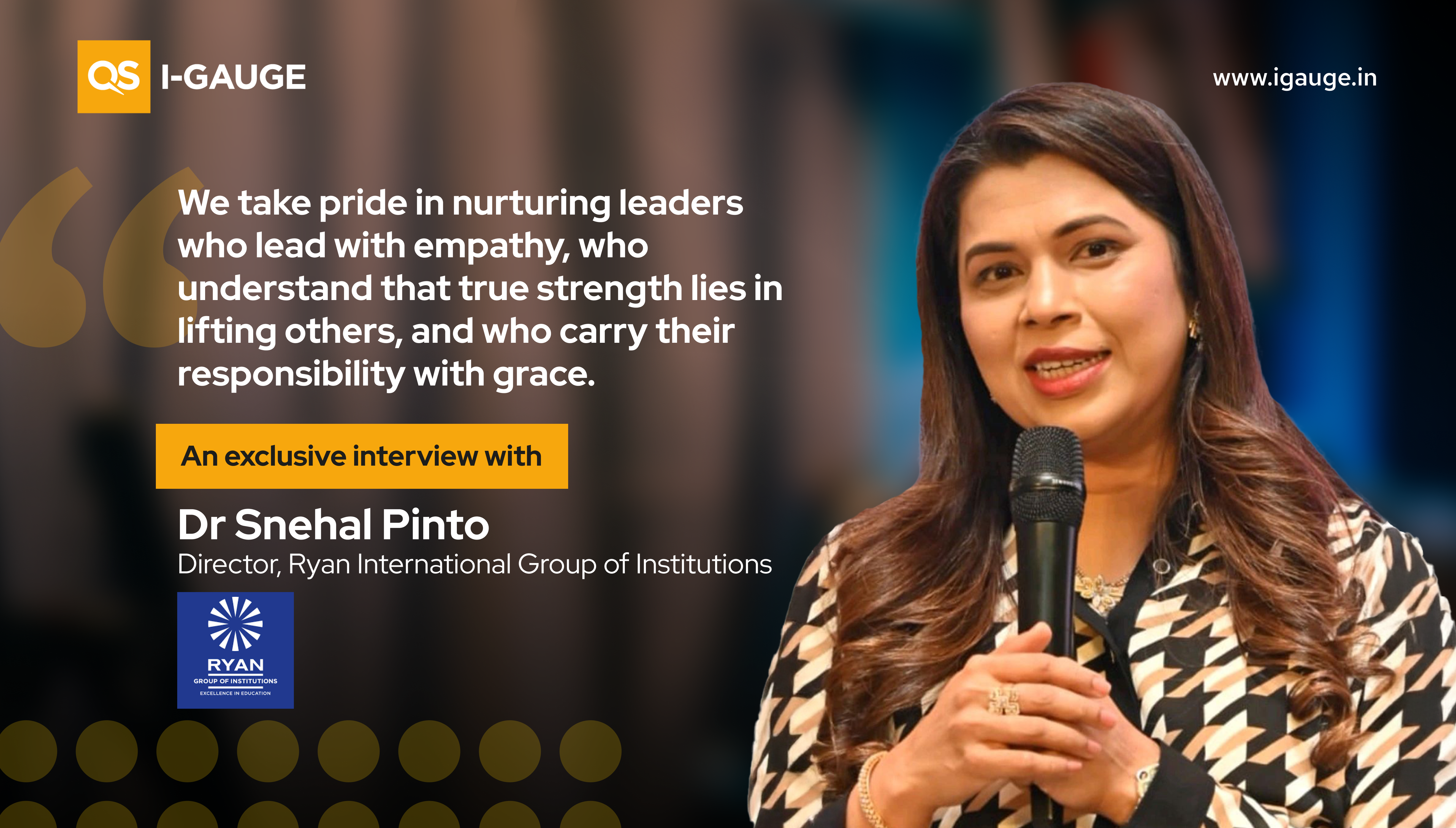.png)
Written by Dr Himanshu Pawar, Market Research Analyst, QS I-GAUGE and Rahul Sikka, Independent Researcher, Delhi University
The current Finance Minister of India, Nirmala Sitharaman, recently spoke with students and emphasised the importance of teaching financial literacy in schools and universities. Her words, “Teaching financial literacy was very important, and it has to start early,” do not just point towards an ideal scenario but a necessity in a fast-growing economy like India. In this ever-changing global environment, financial literacy can become a crucial catalyst for a country’s future growth and prosperity.
In layman’s language, financial literacy refers to the knowledge and ability to manage one’s finances. It involves understanding topics such as budgeting, saving, investing, borrowing, and managing debt, as well as understanding concepts like interest rates, insurance, taxes, and financial planning.
There are several reasons why financial education is essential in India. Firstly, it empowers individuals to make sound financial decisions throughout their lives about purchasing assets, taking loans, and managing expenses, leading to better economic well-being. Secondly, financial education contributes to building a financially inclusive society. Millions of people in India still lack access to formal banking services and rely on informal sources of credit. Through financial literacy, individuals can understand the importance of bank accounts, digital payment platforms, and accessing formal sources of credit. Lastly, financial literacy also plays a part in the overall economic development of a country. Individuals aware of money management would naturally be able to make better entrepreneurial decisions, creating better employment opportunities and a more productive workforce. Moreover, higher financial literacy will make the population less susceptible to financial scams and better at protecting personal wealth.
Despite these glaring advantages of improved financial literacy, it remains a challenge in India. A survey conducted by the National Centre for Financial Education in 2019 revealed that only 27% of the population in India can be considered financially literate [1]. While these numbers have increased positively from the survey in 2013, it is still a significant cause of concern. According to S&P’s Global Financial Literacy Survey, India is ranked 73rd out of 144 countries [2]concerning financial literacy. While India is growing as an economy, the status of financial literacy does not look promising thus, it is imperative to address the issue and formulate policy changes to integrate financial literacy into the education system.
Why start early?
The problem is not unrecognised by the concerned authorities, and the government has taken initiatives to boost financial literacy in the country. The launch of the National Institute of Financial Management, the National Centre for Financial Education, and various financial awareness campaigns are all positive developments, yet the problem persists.
To tackle this issue effectively, widespread changes in the school system are required. The curriculum in schools and colleges often does not cover personal finance topics, leaving students ill-prepared to navigate the complex financial landscape. While a handful of students who choose to study finance in their advanced years might be equipped with the necessary skills, many of them who choose other disciplines remain oblivious to the financial world. Financial education is more than just a subject to study in colleges; it is an essential life skill and, therefore, requires a more universal approach.
To address this issue, financial education should be incorporated into the school curriculum from an early age. There is scientific evidence to support this argument as well. Bruhn et al. (2014) [3] argue that school-based financial education mitigates the problem of a lack of voluntary financial education in later years. Moreover, providing financial education during the early years could be much more sustainable from a long-term perspective [4,5]. Research conducted by Kaiser & Menkhoff [6] studied the effect of school financial education programs on students using a meta-analysis approach. After reviewing 37 such experiments, they found that a school-based system significantly impacts a student’s financial knowledge. Moreover, the intensity of this impact was highest among the younger students. Thus, imparting financial education at the school level can prove to be an effective solution to high financial literacy problems in India.
Designing a school-based financial education system
To introduce a financial literacy program in the school system, it is necessary to consider all the stakeholders' views and recommendations. School Boards, policymakers, faculty members, financial professionals and even parents need to come together to help design a comprehensive program that can equip young students with the required financial knowledge without increasing the already massive pressure of traditional education. Below are a few recommendations to consider when designing such a system.
An ideal system could include basic concepts of money management, savings, and budgeting at the primary school level, gradually progressing to more advanced topics in higher grades. Additionally, the education institutions should offer specialised courses on personal finance and investment management to equip students with practical knowledge.
To begin with, it is essential to understand the format in which these topics would be introduced in the system. The two obvious choices would be either to have a full-fledged subject on financial literacy for students across grades or a session-based learning approach spread across a few hours during a school year. The latter could benefit from not increasing a student’s workload significantly. On average, Indian students from sixth to eighth grade spend nearly 1000 hours in school over 220 days [7]. Instead of increasing these hours, a mere 20-30 hours can be compensated and taken out for financial education. Hour-long weekly sessions could be enough for students to gain the necessary knowledge.
These sessions could be introduced as early as the sixth standard for students. During this age, a child is on the cusp of being a teenager; thus, a basic knowledge of money should be expected, which would be the right opportunity to expand their horizons. A curriculum should begin with an understanding of money, introducing the concept of savings and expenditure. Moreover, parents can be encouraged to trust their children with a pocket-money system. This would help them understand the concepts of savings and expenditure more practically. They would understand the importance of savings, which can open a path to a goal-oriented approach to managing savings and expenses. If a strong base is created, the students should naturally start making conscious decisions about balancing current benefits and future goals. Gradually, the concept of budgeting will become relevant and can be introduced as the knowledge and curiosity of students increase.
Once the basic concepts are well established, the later years can be utilised to introduce different savings avenues to the students. Students beyond the eighth grade can be familiarised with the concept of banks. A Student should be able to answer basic questions like, What is a bank? What does it do? How can it be useful? Beginning from the concept of deposits and withdrawals to eventually introducing different types of accounts would help students utilise their savings effectively. At this point, parents should also be encouraged to discuss their practical monetary situations at home with their children. In addition to having an educational benefit, this would also help children understand monetary limitations, which could help them make more mature decisions regarding their finances.
From grades tenth to twelfth, students are expected to be more mature as they approach adulthood; thus, more advanced knowledge holds higher relevance. The curriculum can begin with the concepts of interest rates and compounding. Students should be made aware of the process of converting savings into investments. Introducing the concept of the time value of money to eventually spread awareness about different avenues of investment can be done during these years. This would also be an appropriate time to introduce some guest lectures from industry professionals, which could be beneficial in imparting some practical knowledge about the financial world. An introduction to financial markets, basic taxation concepts, and insurance would serve the students well in their final years of school education. Eventually, these students should be able to gain enough knowledge to help them make sound financial decisions in the future.
Another critical question to answer is the nature of the assessment for this system. While a proper assessment system, like other mandatory subjects, could give more incentive to students for effective participation, the added pressure could also prove counterproductive. A system of extra credit and certifications can be introduced to incentivise student participation.
While the above recommendations apply only to the formal education system, there are still individuals outside this scope. Financial education initiatives should be extended to communities through workshops, seminars, and digital platforms to reach individuals outside the formal education system. Financial institutions, government agencies, and non-profit organisations should collaborate to develop comprehensive financial literacy programs catering to different societal segments.
Mentioned in this article are just some of the many approaches that can be undertaken, but an effective system can only be developed through active participation from all the stakeholders. The benefits of financial education in India are vast. It is the keystone through which financial inclusion can be fostered, individuals can be empowered, and economic growth can be stimulated. By incorporating financial literacy into the education system and reaching out to underserved communities, India can build a financially literate nation that is well-equipped to tackle the challenges of the future.
References
[1] RBI. (2020). National Strategy for Financial Education: 2020-2025. https://www.rbi.org.in/scripts/PublicationReportDetails.aspx?UrlPage=&ID=1156#:~:text=3.3%20The%20Survey%20conducted%20in,9)%20and%206%20in%20Financial
[2] Klapper, L., Lusardi, A., & Oudheusden, P. van. (2015). Financial Literacy Around the World: Insights From The Standard & Poor’s Rating Services Global Financial Literacy Survey.
[3] Bruhn, M., Lara Ibarra, G., & McKenzie, D. (2014). The minimal impact of a large-scale financial education program in Mexico City. Journal of Development Economics, 108, 184–189. https://doi.org/https://doi.org/10.1016/j.jdeveco.2014.02.009
[4] Frisancho, V. (2018). The impact of school-based financial education on high school students and their teachers: Experimental evidence from Peru.
[5] Lührmann, M., Serra-Garcia, M., & Winter, J. (2018). The impact of financial education on adolescents’ intertemporal choices. American Economic Journal: Economic Policy, 10(3), 309–332.
[6] Kaiser, T., & Menkhoff, L. (2020). Financial education in schools: A meta-analysis of experimental studies. Economics of Education Review, 78, 101930. https://doi.org/https://doi.org/10.1016/j.econedurev.2019.101930
[7] Rajadhyaksha, M. (2014, January 6). Indian kids spend too much time at school? Times of India.



